Bahamas to Charleston then New York.
12th - 31st May 2005
At about six pm our autopilot just switched itself off. We'd been having a sporadic problem with the rate fluxgate compass, which has to be mounted high on the mast away from our steel decks and was designed to compensate for the increased roll of the boat in its high position. On several occasions it seemed to be having a problem calculating this compensation, probably due to an electrical fault and had begun to give the autopilot wildly swinging compass heading readings. This in turn led to the poor autopilot trying to correct for the inaccurate ship's heading. Normally by switching off for a while to let it settle down, we'd been able to restart the autopilot without problems. However on this occasion the fault seemed to be a different one. Robbie, our trusty autopilot, just decided he'd had enough and switched himself off completely, refusing to restart.
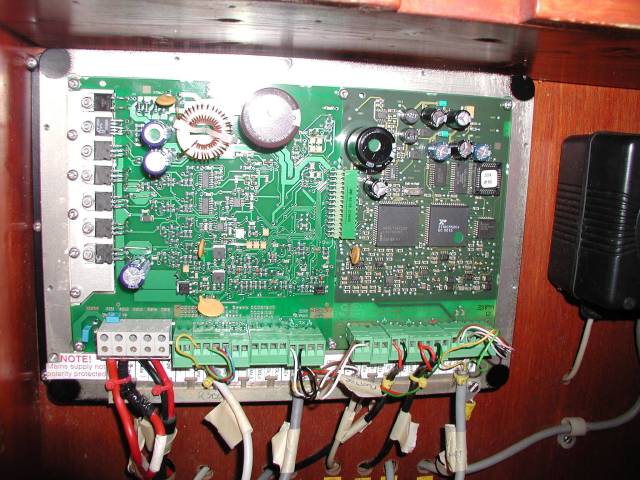
Wondering where to start with the autopilot
Phil began to check over the entire autopilot system searching for a fault. Luckily as we'd fitted the complete system ourselves, he had a bit of a head start but it wasn't an easy job to trace the fault at sea. First we had to dismantle half to the kitchen storage to access the wiring behind, then he climbed up the mizzen mast to check out the compass. This was no easy task particularly with the helmswoman steering a pretty erratic course in the swell with only one hand on the wheel, controlling the mast-climber's safety line with the other. Finally after a couple of hours checking everything we could think of, it appeared that the main power circuit board in the autopilot controller was no longer working and we were faced with the prospect of completing our journey steering by hand.
We were finally approaching Charleston's harbour entrance, when we heard a security call from the Coastguard on the VHF. Our arrival was to coincide with the departure of the Charleston to Bermuda yacht race and we found ourselves picking our way between the racing yachts which were tacking down the narrow channel between the two rock breakwaters.
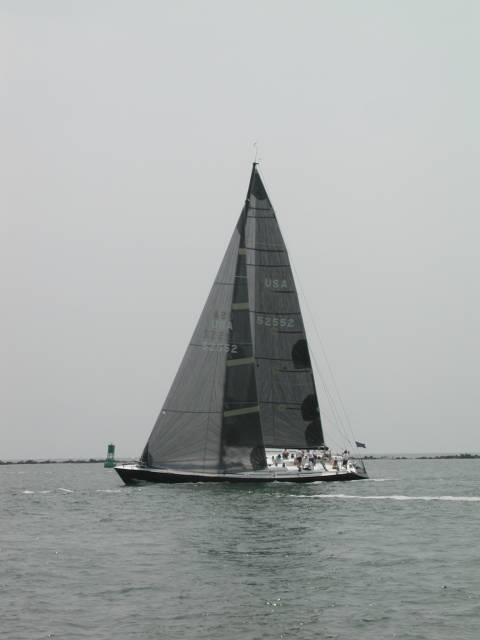
Racing boats sailing faster than Anju motoring
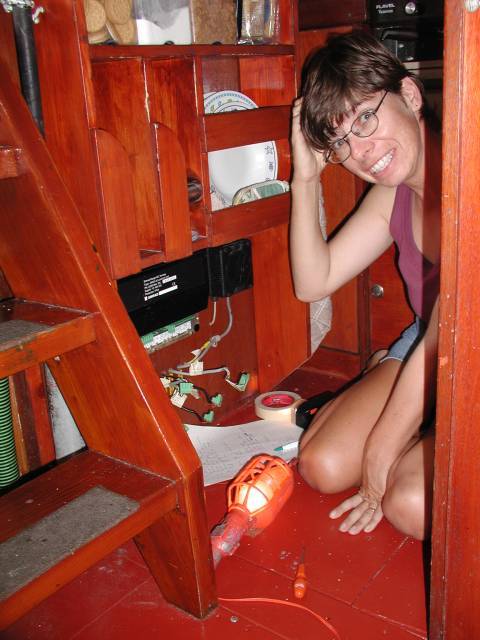
We hired a car and whisked our poorly parts off to Wray Lemke at Mount Pleasant Radio, the local Simrad dealer. He quickly determined that the problem was, as we'd suspected, the power printed circuit board in the controller and ordered a new board to arrive next morning. It was a pretty pricey item at over $700 but hopefully we can get the old one repaired for a spare. It was the first time we'd had to spend money on repairs to the autopilot system after almost 5 years and 20,000 miles of service.
All that remained to do was get the freezer into the dinghy, transfer it safely to the boat, get it through the companionway door (luckily it fit) and find a hole big enough to fit it, plug it in and switch it on. When we discovered the freezer fitted perfectly in its space, we sacrificed our navigation table seat. All our navigation instruments had been re-located into the cockpit and planning charts were usually studied on the larger saloon table, so we rarely used the navigation table in any case.
It was time to get moving again to catch up with our friends on Troubadour, who'd arrived in Beaufort. We took up our anchor and set off. It was time to activate the repaired autopilot and suddenly we found ourselves going in circles in the middle of Charleston Harbour. The more the autopilot tried to turn right to correct, the more the rudder moved to turn us to the left. We quickly realised that the polarity on the power cables from the controller to the autopilot pump must be in opposite polarity to that on the old power board. Phil quickly changed over the leads to the pump motor and everything worked fine.
We headed up the scenic Intracoastal Waterway from Charleston to Georgetown and then, trying to make up the miles quickly, headed out into the Atlantic Ocean for an overnight passage to Cape Fear. Getting out was tough, as we found ourselves beating into 20 knots of wind to get out of the channel before turning for a much more comfortable downwind passage to Cape Fear. Surfing into the inlet at Cape Fear with 25 knots of wind behind us was a battle of nerves but we made it safely and the rising tide whisked us onward towards our intended anchorage at Wrightsville Beach at a rate of around 8 knots. Things were going so well we pressed on all day, spending the night at the anchorage at Mile Hammock Bay, surrounded by the noise of passing military helicopters and bombs exploding at the nearby Marines' training camp.
Next day it was just a short hop to Beaufort where we rejoined our friends Kate and David on Troubadour, literally. We rafted Anju alongside Troubadour on the mooring buoy lent to them by friends. They'd been assured it was the strongest mooring buoy in Beaufort and often used by three boats rafting together. Later that evening as a severe thunderstorm passed over we certainly put it to the test when the wind piped up to around 40 knots for a while. We were happy we were rafted together as we were aboard Troubadour at the time enjoying dinner and only had to step over to Anju to check everything was OK when the storm passed overhead.
After spending a couple of pleasant days in Beaufort we headed on another 10 miles to the Nature Reserve at Point Lookout. As we dropped our anchor, a large leatherback turtle surfaced next to Anju to take a look at us. This would cut ten miles off the next stage of our trip north and also allowed some very rewarding beachcombing before we left.
During the next leg of our trip we had to round the notorious Cape Hatteras but had a pleasant trip thanks to accurate weather routing by our weatherman Chris Parker.
After spending the first night peacefully heading north, we found ourselves invaded by a swarm of black flies which must have been blown offshore. At first there was just a handful of them, then tens, shortly later hundreds and after that we lost count. Normally we would have left them alone to buzz off again but when they started giving us nasty bites, war was declared. We spent the day sealed in the baking heat inside our cockpit cover, swatting any of the beasties who found their way inside and as evening fell and the flies became sluggish with the cold we set to work with our swatters, leaving Anju's deck looking like a battlefield, littered with corpses.
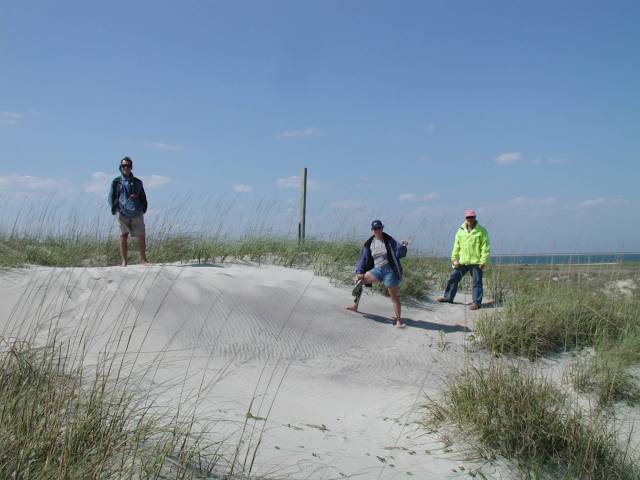
Beachcombing at Point Lookout
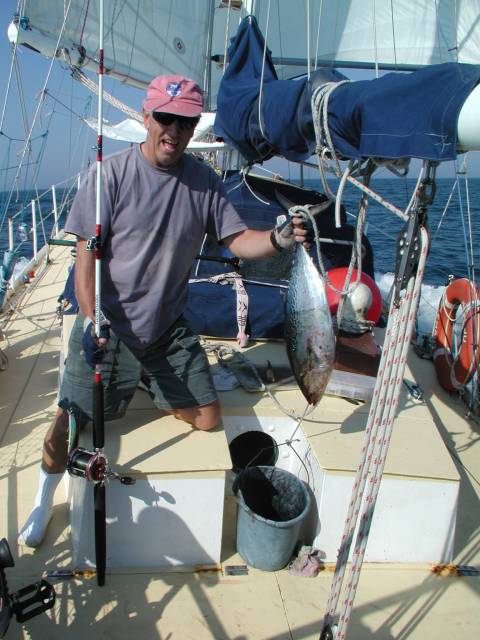
At least we got our fishing done before the aerial attack!
It was important to calculate the tides correctly for our approach to New York as progress would be very slow if we were to get it wrong. Luckily for us, based on our planning we were able to have a lie-on in Cape May before leaving after lunch for another overnight trip. Although there was no moon to speak of, the glaring lights from the casinos at Atlantic City in New Jersey lighted the sky for a while.
After reeling in a couple of bluefish for our freezer next morning, we were rapidly approaching the Manhattan skyline.
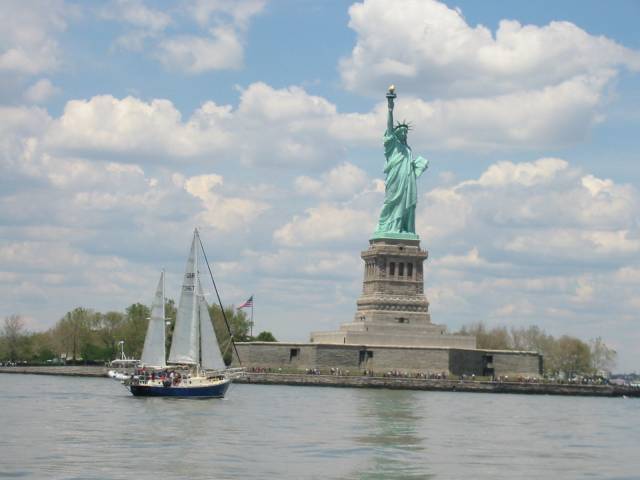
"I never knew it was green!" exclaimed Christine as they sailed by the Statue of Liberty.
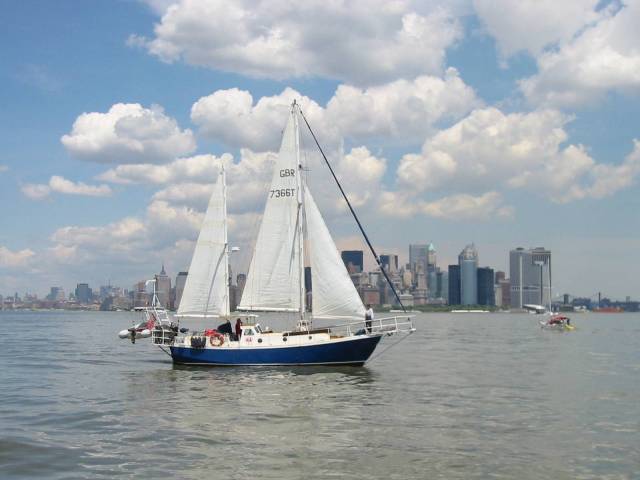
Anju sailing past Manhattan (OK we did have the engine on)
We made our way up the Hudson River to pick up a mooring buoy at the 79th Street Boat Basin. It was time to explore the Big Apple!